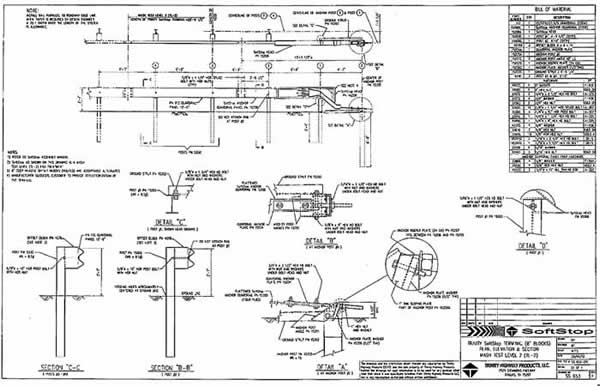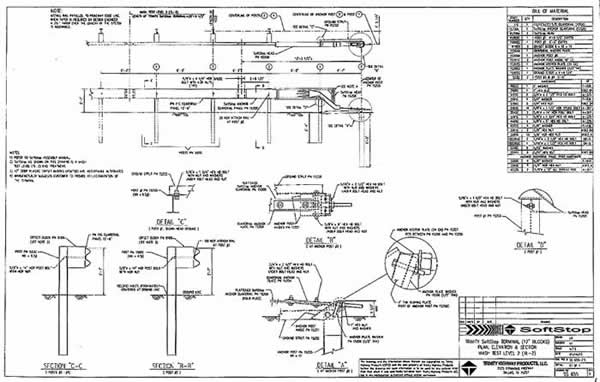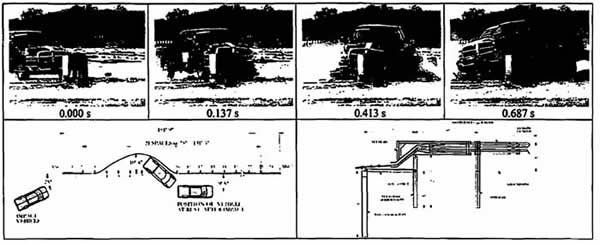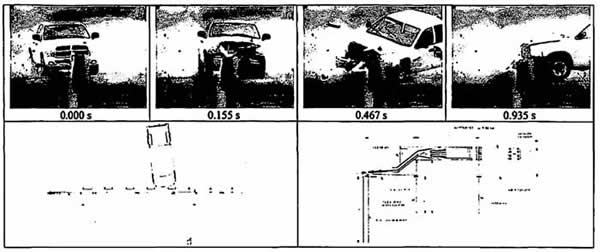U.S. Department of Transportation
Federal Highway Administration
1200 New Jersey Avenue, SE
Washington, DC 20590
202-366-4000

U.S. Department of Transportation
Federal Highway Administration
1200 New Jersey Ave. S.E.
Washington, D.C. 20590
May 1, 2013
In Reply Refer To: HSST/CC-115D
Mr. Brian Smith
Trinity Highway Products, LLC
2525 North Stemmons Freeway
Dallas, Texas 75207
Dear Mr. Smith:
This correspondence supersedes existing eligibility letter HSST/CC-115A dated September 7, 2012 and is in response to your request for additional system details for furthered consideration for Federal Highway Administration (FHWA) review of the as-described roadside safety system for eligibility for reimbursement under the Federal-aid highway program.
| Name of system: | Trinity TL3 SOFT-STOP Terminal |
|---|---|
| Type of system: | W-Beam Guardrail Terminal |
| Test Level: | MASH Test Level 3 (TL-3) |
| Testing conducted by: | Original testing by Texas Transportation Institute |
| Task Force 13 Designator: | SEW23C |
| Date of request: | January 23, 2013 |
| Date to final package | April 12, 2013 |
Decision:
The following device is eligible, with details provided in the form which is attached as an
integral part of this letter.
Based on a review of previous crash tests submitted by the manufacturer certifying the device described herein meets the crash test and evaluation criteria of the American Association of State Highway and Transportation Officials’ Manual for Assessing Safety Hardware (MASH), the device is eligible for reimbursement under the Federal-aid highway program. Eligibility for reimbursement under the Federal-aid highway program does not establish approval or endorsement by the FHWA for any particular purpose or use.
The FHWA, the Department of Transportation, and the United States Government do not endorse products or services and the issuance of a reimbursement eligibility letter is not an endorsement of any product or service.
Requirements
To be found eligible for Federal-aid funding, roadside safety devices should meet the crash test
and evaluation criteria contained in the American Association of State Highway and
Transportation Officials’ Manual for Assessing Safety Hardware (MASH).
Description
The device and supporting documentation are described in the attached form.
Summary and Standard Provisions
Therefore, the system described and detailed in the attached form is eligible for reimbursement
and may be installed under the range of conditions tested.
Please note the following standard provisions that apply to FHWA eligibility letters:
Sincerely yours, /* Signature of Michael S. Griffith */
|
|||
Enclosures
| Submitter | Date of Request: | April 11, 2013 |
| Name: | Don Gripne | |
| Company: | TRINITY HIGHWAY PRODUCTS, LLC | |
| Address: | 2525 STEMMONS FREEWAY, DALLAS, TX 75207 | |
| To: | Michael S. Griffith, Director FHWA, Office of Safety Technologies |
I request the following devices be considered eligible for reimbursement under the Federal-aid highway program.
| System Type | Device Name/Variant | Testing Criterion | Test Level |
|---|---|---|---|
| 'CC': Crash Cushions, Attenuators, & | Trinity TL-3 SOFT-STOP Terminal | AASHTO MASH | TL3 |
By submitting this request for review and evaluation by the Federal Highway Administration, I certify that the product(s) was (were) tested in conformity with the AASHTO Manual for Assessing Safety Hardware and that the test of evaluation results meet the appropriate evaluation criteria in the MASH.
Identification of the individual or organization responsible for the product: /s/ Don Jay Gripne
| Contact Name: | BRIAN SMITH |
| Company Name: | TRINITY HIGHWAY PRODUCTS, LLC |
| Address 1: | 2525 STEMMONS FREEWAY |
| Address 2: | |
| City/State/Zip | DALLAS, TX 75207 |
| Country: | USA |
| Modification to Existing Hardware Non-Significant-Effect is postive or Inconsequential | ||
The original crash test of the Trinity Soft Stop (TTICrash Report 2009) as per Eligibility Letter CC-115 dated December 19, 2011 specified steel post and w-beam guardrail using 12-inch wood block out. The crash test was conducted by Texas Transportation Institute (TTI) entitled NCHRP 350 Crash Testing and Evaluation of the Vertical Squisher' dated February 2009 (TTI Crash Report 2009). This request is to accept the as-tested article as per CC-11 5 for the following:
This modification is considered Non-significant, Effect is Positive or Inconsequential. |
||
| Submitter | Date of Request: | April 12, 2013 |
| Name: | Don Gripne | |
| Company: | TRINITY HIGHWAY PRODUCTS, LLC | |
| Address: | 2525 STEMMONS FREEWAY, DALLAS, TX 75207 | |
| To: | Michael S. Griffith, Director FHWA, Office of Safety Technologies |
I request the following devices be considered eligible for reimbursement under the Federal-aid highway program.
| System Type | Device Name/Variant | Testing Criterion | Test Level |
|---|---|---|---|
| 'CC': Crash Cushions, Attenuators, & | Trinity TL-3 SOFT-STOP TERMINAL | AASHTO MASH | TL3 |
By submitting this request for review and evaluation by the Federal Highway Administration, I certify that the product(s) was (were) tested in conformity with the AASHTO Manual for Assessing Safety Hardware and that the test I evaluation results meet the appropriate evaluation criteria in the MASH.
Identification of the individual or organization responsible for the product:
| Contact Name: | BRIAN SMITH |
| Company Name: | TRINITY HIGHWAY PRODUCTS, LLC |
| Address 1: | 2525 STEMMONS FREEWAY |
| Address 2: | |
| City/State/Zip | DALLAS, TX 75207 |
| Country: | USA |
| Modification to Existing Hardware Non-Significant-Effect is postive or Inconsequential | ||
The original crash test of the Trinity Soft Stop (TTICrash Report 2009) as per Eligibility Letter CC-115 dated December 19, 2011 specified steel post and w-beam guardrail using 12-inch wood block out. The crash test was conducted by Texas Transportation Institute (TTI) entitled NCHRP 350 Crash Testing and Evaluation of the Vertical Squisher' dated February 2009 (TTI Crash Report 2009). This request is to accept the as-tested article as per CC-11 5 for the following:
This modification is considered Non-significant, Effect is Positive or Inconsequential. |
||
A brief description of each crash test and its result:
| Required Test Number | Narrative Description | Evaluation Results |
|---|---|---|
| 3-30 (1100C) | As per TTI Crash Report 2009, an 1100C (2425 lb) passenger car impacting the terminal end-on at a nominal impact speed and angle of 62 mi/h and 0 degree, respectively, with the quarter point of the vehicle aligned with the center line of the nose of the terminal. This test is primarily intended to evaluate occupant risk and vehicle trajectory criteria. The SOFT-STOP slowed and redirected the 1100C vehicle. No occupant compartment deformation occurred. The 1100C vehicle remained upright during and after the collision event. Maximum roll was 25 degrees, and maximum pitch was 7 degrees. Occupant risk factors were within the limits specified for MASH test 3-30. The vehicle subsequently came to rest 27 feet downstream of impact and 34 feet toward traffic lanes. The SOFT-STOP performed acceptably according to the evaluation criteria of MASH test 3-30. | WAIVER REQUES |
| 3-31 (2270P) | As per TTI Crash Report 2009, A 2270P (5000 lb) pickup truck impacting the terminal end-on at a nominal impact speed and angle of 62 mi/h and 0 degree, respectively, with the center line of the vehicle aligned with the center line of the nose of the terminal. This test is primarily intended to evaluate occupant risk and vehicle trajectory criteria. The SOFT-STOP brought the 2270P vehicle to a controlled stop. No occupant compartment deformation occurred. The 2270P vehicle remained upright during and after the collision event. Maximum roll was 4 degrees, and maximum pitch was -3 degrees. Occupant risk factors were within the limits specified for MASH test 3-31. The 2270P vehicle came to rest within the installation. The SOFT-STOP performed acceptably according to the evaluation criteria of MASH test 3-31. | WAIVER REQUES |
| 3-32 (1100C) | As per TTI Crash Report 2009, an 1100C (2425 lb) passenger car impacting the terminal end-on at a nominal impact speed and angle of 62 mph and 5/15 degrees, respectively, with the center line of the vehicle aligned with the center line of the nose of the terminal. This test is primarily intended to evaluate occupant risk and vehicle trajectory criteria. The SOFT -STOP slowed and stopped the 1100C vehicle. No occupant compartment deformation occurred. The 1100CC vehicle remained upright during and WAIVER REQUES after the collision event. Maximum roll was 28 degrees, and maximum pitch was -26 degrees. Occupant risk factors were within the limits specified for MASH test 3-32. The vehicle subsequently came to rest with the front of the vehicle adjacent to post 4 of the terminal, with most of the vehicle toward the field side. The SOFT-STOP performed acceptably according to the evaluation criteria of MASH test 3-32. | WAIVER REQUES |
| 3-33 (2270P) | As per TTI Crash Report 2009, the 2000P vehicle, traveling at an impact speed of 62.7 mi/h, impacted the nose of the Vertical Squisher end-on at an impact angle of 16.3 degrees. At 0.044 s after impact, the head of the terminal began to move along the rail, and at 0.093 s, the 2000P vehicle began to redirect toward the field side. The front right tire contacted the terminal at 0.207 s. The vehicle began to travel parallel with the guardrail at 0.285 s, at a speed of 48.2 mi/h (77.6 km/h). At 0.372 s, the 2000P vehicle overrode the terminal and lost contact with the guardrail and was traveling at an exit speed and angle of 51.7 mi/h (83.2 km/h) and 1.8 degrees, respectively. After completely exiting the installation, the 2000P vehicle partially traversed a steep mound of soil and came to rest on its right side 242 ft downstream and 30 ft toward the field side. | WAIVER REQUES |
| 3-34 (1100C) | As per TTI Crash Report 2009, an 1100C (2425 lb) passenger car impacting the terminal at a nominal impact speed and angle of 62 mi/h and 15 degrees, respectively, with the comer of the vehicle bumper aligned with the critical impact point (CIP) of the length of need (LON) of the terminal. This test is primarily intended to evaluate occupant risk and vehicle trajectory criteria. The SOFT-STOP contained and redirected the 1100C vehicle. The vehicle did not penetrate or override the installation. Maximum dynamic deflection was 1.96 feet and the head fed through 6.2 feet of w-beam rail element. Maximum occupant compartment deformation was 1.0 inch inward in the area of the instrument panel on the left side. The 1100C vehicle remained upright during and after the collision event. Maximum roll was 10 degrees, and maximum pitch was -4 degrees. Occupant risk factors were within the limits specified for MASH test 3-34. The vehicle subsequently came to rest 15 feet toward traffic lanes in front of post 8. The SOFT-STOP performed acceptably according to the evaluation criteria of MASH test 3-34. | WAIVER REQUES |
| 3-35 (2270P) | As per TTI Crash Report 2009, a 2270P (5000 lb) pickup truck impacting the terminal at a nominal impact speed and angle of 62 mi/h and 25 degrees, respectively, with the comer of the vehicle bumper aligned with the beginning of the LON of the terminal. This test is primarily intended to evaluate structural adequacy and vehicle trajectory criteria. The SOFTSTOP contained and redirected the 2270P. The vehicle did not under ride or override the installation. Although the w-beam rail anchorage released late in the impact event, the vehicle did not penetrate the installation. While the vehicle was in contact with the w-beam, the maximum dynamic deflection was 10.4 feet However, the upstream anchor released and as the vehicle lost contact with the w-beam, the w-beam continued to deflect, reaching a maximum displacement of 11.6 feet. The kickpanel of the left side was deformed inward 0.4 inch. The 2270P vehicle remained upright during and after the collision event. Maximum roll was -30 degrees, and maximum pitch was -12 degrees. Occupant risk factors were within the preferred limits specified for MASH test 3-31. The 2270P vehicle exited within the exit box. The SOFT-STOP performed acceptably according to the evaluation criteria of MASH test 3-35. | |
| 3-36 (2270P) | As per TTI Crash Report 2009, a 2270P (5000 lb) pickup truck impacting
the terminal at a nominal impact speed and angle of 62 mi/h and 25
degrees, respectively, with the comer of the vehicle bumper aligned with
the CIP with respect to the transition to the stiff barrier or backup
structure. As a w-beam guardrail terminal, the SOFT-STOP will never be
attached directly to a backup structure, and the transition to a stiff barrier
is basically at Post 3. Therefore, Trinity feels that Test 3-36 is irrelevant and
was therefore not conducted. |
WAIVER REQUES |
| 3-37 (2270P) | As per TTI Crash Report 2009, a 2270P (5000 1b) pickup truck impacting
the terminal at a nominal impact speed and angle of 62 mi/h and 25 degrees, respectively, mid-point between the nose and the end of the terminal in the reverse direction. This test is intended to evaluate the performance of a terminal for a "reverse" hit. However, researchers at TTI believe that the reverse direction impact would be more critical for the 1100C (2425 lb) passenger car than for the 2270P pickup. Therefore, an
1100C (2425 lb) passenger car was used in Test 3-37. Eligibility Letter CC-115 indicated that the substitution of the 1100C vehicle to evaluate the reverse direction impact was appropriate. |
WAIVER REQUES |
| 3-38 (1500A) | As perm Crash Report 2009, a 1500A (3307 lb) passenger car impacting the terminal end-on at a nominal impact speed and angle of 62 mi/h and 0 degree, respectively, with the center line of the vehicle aligned with the
center line of the nose of the terminal. This test is primarily intended to
evaluate the performance of the staged attenuator/terminal when
impacted by a mid-size vehicle. The SOFT-STOP is not a staged device.
Therefore Test 3-38 was not conducted. However, as per Appendix G of
MASH, calculations based on Test 3-31 have been performed to predict
the occupant risk values for the 1500A (3307lb) vehicle. The results of
these calculations (shown on the enclosed document) predict that in crash testing with the 1500A (3307lb) vehicle, the SOFT-STOP Terminal, would perform acceptably according to the Test Level3 (TL-3) evaluation criteria set out in the MASH guidelines for terminals. Eligibility Letter CC-115 indicates that test 3-38 is not necessary because the SOFT-STOP is not a staged device and that manufacturers calculations predict crash worthy performance with the 1500A vehicle. |
|
| 3-40 (1100C) | Does not apply to non-gating/energy absorbing devices. | |
| 3-41 (2270P) | Does not apply to non-gating/energy absorbing devices. | |
| 3-42 (1100C) | Does not apply to non-gating/energy absorbing devices. | |
| 3-43 (2270P) | Does not apply to non-gating/energy absorbing devices. | |
| 3-44 (2270P) | Does not apply to non-gating/energy absorbing devices. | |
| 3-45 (1500A) | Does not apply to non-gating/energy absorbing devices. |
Full Scale Crash Testing was done in compliance with MASH by the following accredited crash test laboratory (cite the laboratory's accreditation status as noted in the crash test reports.):
| Laboratory Name: | Texas Transportation Institute |
| Laboratory Contact: | Dean Alberson |
| Address: | 3135 TAMU, College Station, TX. 77843-3135 |
| Country: | USA |
| Accreditation Certificate Number and Date: |
Mechanical 2821.01, Current date April 30, 2013 |
Attach to this form:
FHWA Official Business Only:
| Eligibility Letter | AASHTO TF13 | Key Words | |
|---|---|---|---|
| Number | Date | Designator | |
| CC-115D | April 22,2013 | SEW22B | TL3, non-gating/energy absorbing terminal, tensioned w-beam guardrail terminal, steel yielding terminal posts, deflector terminal head |



| General Information | Impact Conditions | Post-Impact Trajectory | |||
| Test Agency | Texas Transportation Institute | Speed | 63.5 mi/h | Stopping Distance | 62.5 ft dwnstrm 9.4 ft twd traffic |
| Test No. | 400001-TSQ1 | Angle | 26.4 degrees | Vehicle Stability | |
| Date | 2009-10-01 | `Location/Orientation | At Post 3 | Maximum Yaw Angle | 74 degrees |
| Test Article | Exit Conditions | Maximum Pitch Angle | -12 degrees | ||
| Type | Terminal | Speed | Out of view | Maximum Roll Angle | -30 degrees |
| Name | Vertically Loading Terminal (VLT) | Angle | Out of view | Vehicle Snagging | No |
| Installation Length | 151.75 ft. | Occupant Risk Values | Vehicle Pocketing | No | |
| Material or Key Element | 31 in tall 12 ga w-beam, steel posts | Impact Velocity | Test Article Deflections | ||
| Soil Type and Condition | Standard Soil, Damp | Longitudinal | 15.8 ft/s | Dynamic | 11.6 ft |
| Test Vehicle | Lateral | 14.4 ft/s | Permanent | 11.2 ft | |
| Type/Designation | 2270P | Ridedown Accelerations | |||
| Make and Model | 2003 Dodge Ram 1500 quad-cab pickup | Longitudinal | -11.0 G | Working Width | 10.4 ft |
| Curb | 4708 lb | Lateral | 7.9 G | Vehicle Damage | |
| Test Inertial | 5028 lb | THIV | 21.0 km/h | VDS | 11LFQ4 |
| Dummy | No dummy | PHD | 11.6 G | CDC | 11FDEW3 |
| Gross Static | 5028 lb | Max. 0.050-s Average | Max. Exterior Deformation | 16.0 inches | |
| Longitudinal | -4.7 G | Max. Occupant Compartment Deformation | 0.4 inches | ||
| Lateral | 5.0 G | ||||
| Vertical | 2.5 G | ||||
Summary of results for MASH test 3-35 on the VLT.

| General Information | Impact Conditions | Post-Impact Trajectory | |||
| Test Agency | Texas Transportation Institute | Speed | 60.9 mi/h | Stopping Distance | 28 ft dwnstrm Adjent to field side |
| Test No. | 400001-TSQ1 | Angle | 7.3 degrees | Vehicle Stability | |
| Date | 2009-10-01 | `Location/Orientation | End-on | Maximum Yaw Angle | 85 degrees |
| Test Article | Exit Conditions | Maximum Pitch Angle | 5 degrees | ||
| Type | Terminal | Speed | Out of view | Maximum Roll Angle | -21 degrees |
| Name | Vertically Loading Terminal (VLT) | Angle | Out of view | Vehicle Snagging | No |
| Installation Length | 151.75 ft. | Occupant Risk Values | Vehicle Pocketing | No | |
| Material or Key Element | 31 in tall 12 ga w-beam, steel posts | Impact Velocity | Test Article Deflections | ||
| Soil Type and Condition | Standard Soil, Damp | Longitudinal | 21.0 ft/s | Dynamic | 2.0 ft |
| Test Vehicle | Lateral | 3.0 ft/s | Permanent | 2.0 ft | |
| Type/Designation | 2270P | Ridedown Accelerations | |||
| Make and Model | 2003 Dodge Ram 1500 quad-cab pickup | Longitudinal | -9.5 G | Working Width | 14.7 ft |
| Curb | 4695 lb | Lateral | 3.8 G | Vehicle Damage | |
| Test Inertial | 4958 lb | THIV | 23.3 km/h | VDS | 12FC5 |
| Dummy | No dummy | PHD | 9.7 G | CDC | 12FCEN4 |
| Gross Static | 4958 lb | Max. 0.050-s Average | Max. Exterior Deformation | 17.75 inches | |
| Longitudinal | -7.3 G | Max. Occupant Compartment Deformation | 0 | ||
| Lateral | 2.8 G | ||||
| Vertical | 3.1 G | ||||
Summary of results for MASH test 3-33 on the VLT.

| General Information | Impact Conditions | Post-Impact Trajectory | |||
| Test Agency | Texas Transportation Institute | Speed | 61.1 mi/h | Stopping Distance | 37.5 ft dwnstrm Over posts 6-7 |
| Test No. | 400001-TSQ7 | Angle | 1.4 degrees | Vehicle Stability | |
| Date | 2010-01-12 | `Location/Orientation | End-on | Maximum Yaw Angle | 3 degrees |
| Test Article | Exit Conditions | Maximum Pitch Angle | -3 degrees | ||
| Type | Terminal | Speed | Out of view | Maximum Roll Angle | 4 degrees |
| Name | Vertically Loading Terminal (VLT) | Angle | 5.0 degrees | Vehicle Snagging | No |
| Installation Length | 151.75 ft. | Occupant Risk Values | Vehicle Pocketing | No | |
| Material or Key Element | 31 in tall 12 ga w-beam, steel posts | Impact Velocity | Test Article Deflections | ||
| Soil Type and Condition | Standard Soil, Damp | Longitudinal | 20.0 ft/s | Dynamic | 45.7 ft |
| Test Vehicle | Lateral | 0.0 ft/s | Permanent | 45.7 ft | |
| Type/Designation | 2270P | Ridedown Accelerations | |||
| Make and Model | 2002 Dodge Ram 1500 quad-cab pickup | Longitudinal | -8.6 G | Working Width | 4.4 ft |
| Curb | 5024 lb | Lateral | -2.3 G | Vehicle Damage | |
| Test Inertial | 5024 lb | THIV | 21.8 km/h | VDS | 12FC5 |
| Dummy | No dummy | PHD | 8.6 G | CDC | 12FCEN4 |
| Gross Static | 5084 lb | Max. 0.050-s Average | Max. Exterior Deformation | 17.0 inches | |
| Longitudinal | -5.0 G | Max. Occupant Compartment Deformation | 0 | ||
| Lateral | 0.8 G | ||||
| Vertical | 2.3 G | ||||
